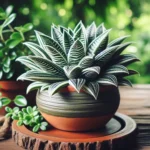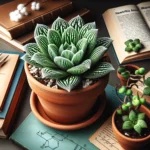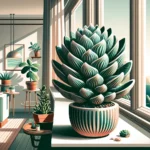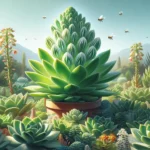Introduction to Haworthia Zebra Plant
Welcome to the world of the Haworthia Zebra Plant, a charming succulent that’s won the hearts of plant lovers everywhere. This small, low-growing plant is a true gem in any succulent collection, with its striking dark green leaves decorated with bolder white stripes that resemble a zebra’s skin. Originating from the Eastern Cape province of South Africa, the Zebra Plant—often go-to choice for both newbies and seasoned succulent connoisseurs.
Delving into the allure of the Haworthia Zebra Plant, one can’t help but admire its resilience and adaptability. It thrives in conditions that would make most other plants wither, making it an exceptional choice for those who admire beauty without the hassle. Imagine this: a busy office desk, flanked by the enchanting presence of Zebra Plants, bringing a piece of the wild and exotic indoors with minimal effort.
Engaging with enthusiasts: On a sunny ledge in a plant enthusiast’s home, the Zebra Plant’s vivid patterns stand out among other green companions, sparking curiosity and conversation among visitors. It’s more than just a plant; it’s a living piece of art that invites onlookers to take a closer glimpse into nature’s intricate designs.
For a more in-depth dive into the world of these mesmerizing succulents, you might find this resource on Zebra Plant care tips quite enlightening. And if you’re eager to expand your succulent knowledge, why not explore the broader universe of these resilient plants with our guide on the ultimate care for succulents.
For visual learners eager to see this succulent in action, here’s a handy video that captures the essence of Haworthia Zebra Plant care, ensuring your striped companion remains healthy and striking:
As you continue your journey through the world of succulents, the Haworthia Zebra Plant remains a delightful enigma, promising to elevate both your living space and your gardening craft. Now that you’ve been introduced to this dazzling denizen of the desert, it’s time to unveil its secrets and bask in its enduring allure.
Physical Characteristics and Varieties
Meet the Haworthia Zebra Plant, a succulent charmer that’s making waves among indoor plant enthusiasts! Known scientifically as Haworthia attenuata, this pint-sized powerhouse is like a mini architectural marvel. Now, picture this: shiny, dark green leaves forming a tight rosette, each leaf adorned with silvery-white stripes that are as precise as if lined with painter’s tape. Yes, these are the signature stripes that give our zebra plant its well-earned moniker.
But it’s not all about looks; the Zebra Plant’s robustness and ease of care make it a winner. It thrives in the same conditions that would make other green comrades throw in the leaf—think less-than-subtropical humidity and the limited sun of an apartment. Imagine a friend who thrives on neglect (within reason) and still looks like a runway model—that’s this plant for you!
The geometric beauty of their growth pattern is simply fascinating. Each rosette grows like a carefully crafted spiral, a bit like a succulent Fibonacci sequence. This orderly growth makes them perfect for that minimalistic vibe in your decor. And the variation—oh, the variation! From the classic Haworthia fasciata with its chunky stripes to the Haworthia limifolia with ridges that seem carved from the leafy flesh, each variety is its own little wonder. And for those with a keen eye, the Haworthia reinwardtii with its concentric markings is like a living work of art.
Whether you’re positioning a single Zebra Plant on your sunlit windowsill or dotting them in between books on a shadowy shelf, they adapt and thrive. It brings a slice of the wild right into your urban jungle—no passport required. Ready to make one of these striped jewels a part of your home? Head over to our detailed care guide (don’t worry, it will open in a new window) to learn everything you need to know to keep your Haworthia Zebra Plant happy.
And for those who are diving deeper into the world of succulents, be sure not to miss our in-depth exploration on perfecting your succulent soil blend. Your little striped friends will thank you!
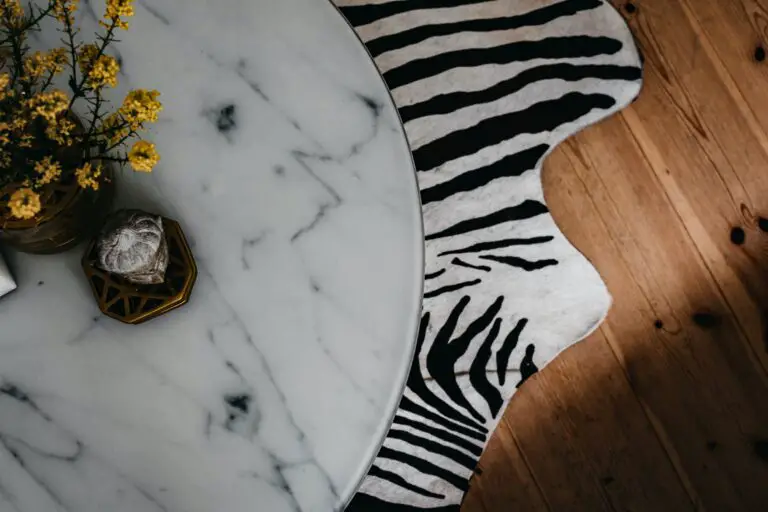
Ideal Growing Conditions
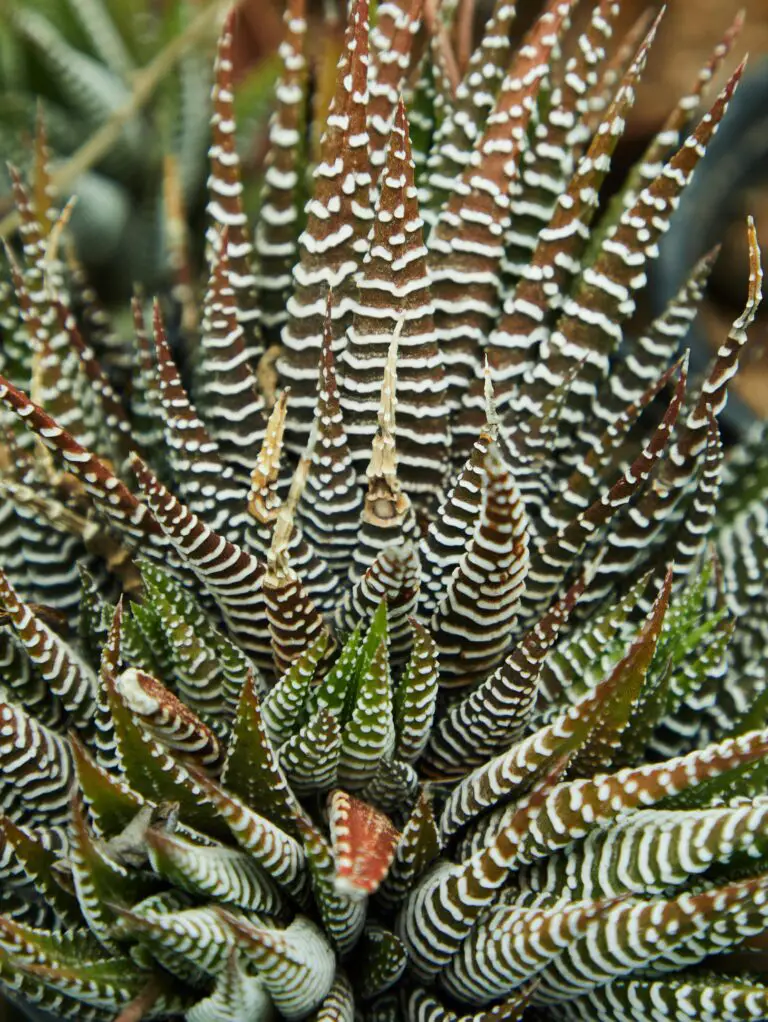
Picturing the perfect environment for your Haworthia Zebra Plant is much like imagining a miniature green oasis. Let’s embark on a journey to understand how you can recreate this little wonder’s native habitat, ensuring it thrives and displays those striking, stripe-filled leaves.
Let There Be Light (But Not Too Much)
The Zebra Plant adores a good sunbath – indirect light, that is. Picture the dappled sunlight under a tree; that’s your sweet spot. This is not a plant that enjoys a tanning session in direct, harsh sunlight. A north-facing window or a spot with bright, filtered light will keep those zebra stripes vivid and well-defined.
Take the Temperature Just Right
Warm and cozy but never too hot – the Zebra Plant, with its cool, calm, and collected demeanor, prefers a stable climate akin to a mild spring day. A temperature range between 65-75°F (18-24°C) makes for an ideal climate. Think of it as the comfort food of temperatures for this succulent.
Humidity: A Delicate Balance
Unlike that steamy tropical rainforest vibe, Haworthia favors a more laid-back approach to humidity. Moderate levels will do just fine; you’re aiming for the sort of atmosphere you might find in a room with air flowing freely – think gentle breezes rather than gusty winds or stagnant air. Avoid the extremes of a dry desert or a humid greenhouse.
Strike the right balance of subtle sunshine, temperate air, and mellow moisture, and you’ll have a Haworthia Zebra Plant that not only survives but also thrives, pampered in conditions that emulate its native South African homelands.
Soil and Watering Recommendations
Embark on a journey to ensure your Haworthia Zebra Plant thrives in its pot! Imagine the perfect bed for a deep sleep; that’s precisely what the right soil mixture is for these striped beauties. It’s all about finding that sweet spot for drainage. A mix of succulent soil combined with sand or perlite creates an open, airy foundation that lets roots breathe and reduces the risk of waterlogging.
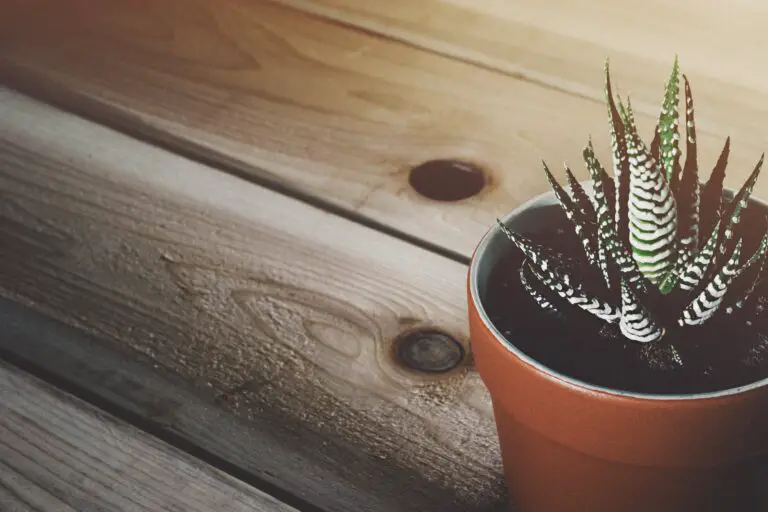
Now let’s talk about hydration—the elixir of life for your Haworthia zebra plant. Watering can feel like navigating a labyrinth; too little and your plant thirsts, too much and the dreaded root rot lurks. The golden rule? Check the soil’s dryness before giving it a drink. If the topsoil feels like a parched desert, it’s time to water. And here’s a pro tip: water deeply but infrequently, soaking the roots and allowing excess to drain freely. Imagine a soft, steady rain that quenches the earth’s thirst without causing a flood.
Consider yourself a guardian of balance, where every drop of water is a step towards lush, vibrant foliage. By following these guidelines, your Haworthia zebra plant won’t just survive; it will flourish, sporting its striking stripes with pride as it basks in the harmony of perfect soil and watering.
Fertilizing and Maintenance Tips
So, you’ve succumbed to the charm of the Haworthia Zebra Plant with its striking stripes and cool, sculptural form—it’s quite the living art piece, isn’t it? Keeping this little gem gleaming means giving it the right nutrients and care, so let’s get into it. Imagine you’re a chef—the Haworthia is your gourmet dish, and fertilizer is the seasoning!
First things first, Haworthias are like those low-maintenance friends we all love—they don’t need to be spoon-fed too often. In fact, feeding them once in the spring and once in the summer with a diluted succulent fertilizer does the trick. Remember, it’s like adding salt to a dish; a little goes a long way, and overdoing it can cause more harm than good.
Now, let’s talk maintenance. These plants are as hardy as they come, but they do have a few nemeses. Imagine you’re crafting a masterpiece, and pests are like those pesky critics. To keep them at bay, a simple neem oil spray used sparsely can act as a shield. For routine care, wipe the leaves with a damp cloth to keep those zebra-like stripes popping! It’s sort of like dusting off a trophy—regular love and attention keep it shining.
Illness for plants is often a soil issue, so make sure your Haworthia is snuggled into well-draining soil. That way, even during those over-enthusiastic watering sessions, it won’t get waterlogged roots, kind of like how you’d save your electronics from a spilled cup of coffee.
Lastly, don’t forget about those comfy conditions. Haworthias enjoy a stable environment—not too hot, not too cold. It’s the Goldilocks of plant care. Aim for moderate temperatures, bright indirect sunlight, and you’ll have a happy camper.
With these tidbits of wisdom, you’re all set to keep your Haworthia Zebra Plant thriving. Treat it right, and it’ll brighten up your space for a long time, just like that favorite piece of decor that always earns compliments.
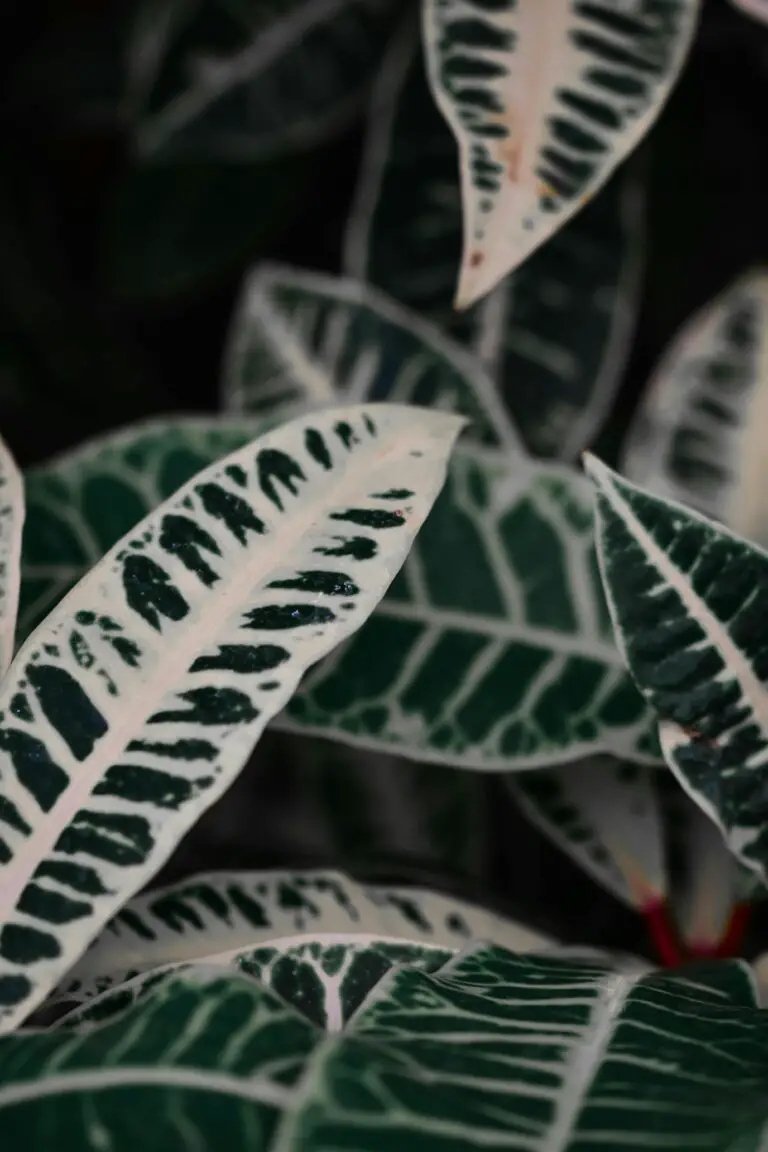
Propagation Techniques
The Haworthia Zebra Plant, a striking succulent with its signature stripes, can easily be multiplied to share with fellow plant enthusiasts or to simply expand your green space. But how does one embark on the journey of propagation? Let’s get to the root of the straightforward yet fascinating process.
Offsets: Nature’s Gift for Easy Propagation
As a generous plant, the Haworthia Zebra Plant produces bountiful offsets, also known as “pups,” that cluster around its base. These mini-me’s are the perfect start for new plants. The key is to wait until the pup forms its own roots, which usually takes a few months. Armed with a clean knife or shears, gently separate the offset from the mother plant, ensuring you get a good portion of the roots. Then, nestle the pup in cactus potting mix and water sparingly. Within weeks, you’ll witness the birth of a new Zebra Plant, ready to flaunt its stripes.

Leaf Cuttings: Patience and Precision
Another propagation path is through leaf cuttings, a slightly more intricate process requiring patience. Select a healthy leaf and make a clean horizontal cut near the base. Let the cutting dry for a couple of days to form a callous, preventing rot when planted. Insert the cut end into a soil blend suited for succulents and provide bright, indirect light. Keep the soil lightly moist, and after several weeks to a couple of months, roots will develop, signaling the start of a new life for your Zebra Plant.
Whether you choose to propagate using offsets or leaf cuttings, remember that both techniques embrace the essence of nurturing life. With each new plant, a story unfolds—a tale of growth, resilience, and the natural wonder of the Haworthia Zebra Plant. As you watch your succulent family grow, you connect deeper with the world of flora, savoring the slow and rewarding art of plant propagation.
Troubleshooting Common Issues
When your Haworthia Zebra Plant starts throwing a tantrum, don’t panic! Yellowing leaves waving a little too lazily? Growth stunted like a teen rebel refusing to hit a growth spurt? We’ve all been there. Let’s dive into the secrets of success with these striped succulents!
Yellow Leaves: Not the Golden Ticket
Picture this: A sun-kissed living room, and your zebra plant, transforming. But wait, those aren’t natural golden stripes; the leaves are yellowing! It’s often a cry for help – too much sun, or it could be drowning in over enthusiasm (read: overwatering). The fix? Slide it into a shadier spot and cut back on the H2O. Your green-thumbed intuition won’t steer you wrong.
Stunted Growth: Short but Not Sweet
It’s like your zebra plant decided to stay pint-sized. Joanne’s plant is soaring sky-high, so why isn’t yours? Could be a soil crime scene—check for compacted or nutrient-deficient soil. Giving it a fresh potting mix might just be the energizing spa day it’s silently pleading for. Remember, stunted growth is a stall, not a stop. There’s always room for a growth spurt with the right care!

Wrinkled Leaves: A Sign of Thirst
Wrinkles on plants? Yes, and it’s not because they’re aging gracefully. It’s a tell-tale sign of dehydration. Before upping the water rations, consider the possibility of root rot. If the roots are swimming rather than sipping, it’s time for a soil check and possibly more drainage. Like camels of the plant world, these succulents need less, but well-regulated water.
While these challenges might make you think your green buddy has decided to rebel against you, fear not. With a bit of patience, troubleshooting, and tender love and care, your Haworthia Zebra Plant will be back on track, boasting its striking stripes proudly for all your plant-loving friends to see.
Decorative Uses in Home and Office
The Haworthia Zebra Plant, with its striking stripes and architectural presence, isn’t just your ordinary succulent. Its compact size and relatively easy care make it a versatile decorative asset in both home and office settings. Imagine miniature green sculptures dotting your workspace, adding a touch of nature’s artistry to your everyday environment.
In the home, the Haworthia Zebra can be a miniature centerpiece on your coffee table or a quirky addition to a windowsill collection. Picture this little striped gem nestled in a terracotta pot amidst a cluster of books, instantly elevating the coziness of your reading nook. Or, how about incorporating it into a bathroom setup? Its low water requirements make it a perfect resident for often overlooked spaces like these.
Turning to the office, this resilient little warrior can withstand the hustle and brawn of the busiest desks. It not only survives but thrives under the glow of fluorescent lights, making it a steadfast companion for those 9-to-5 days. Cluster a few together in a shallow dish garden for a miniature desert escape, or single one out in a sleek, geometric planter for a modern touch that’s sure to spark conversations.
Even more, the Haworthia Zebra is a champion of the ‘shelfie’. It can offer a structured yet edgy aesthetic to open shelving units, especially when paired with books, artisanal objects, and other plant buddies. It’s about creating layers of interest, and this plucky succulent plays the role brilliantly. Want to see the comparison and versatility in action? Take a peek at this video:
Don’t limit yourself to the usual. Have you considered hanging planters? The Haworthia Zebra can adapt to the high life, making it a piece of living decor suspended in the air, adding vitality to any vertical space. And let’s not forget miniature gardens—incorporate this succulent with others of varying shapes and sizes to craft a tiny, enchanting world that provides a green respite in the grey maze of the urban jungle.
In summary, the Haworthia Zebra Plant offers an array of decorative possibilities. With a little creativity, it can seamlessly transition from being a humble potted plant on your windowsill to a striking statement piece wherever it’s placed. Its ability to adapt to various light conditions and design aesthetics makes it the ideal botanical companion for anyone looking to add a dash of green class to their living or working spaces.
Conservation and Ethical Sourcing
When we dive into the world of succulents, the Haworthia zebra plant stands out with its striking striped leaves, charming the hearts of plant enthusiasts worldwide. Yet, beneath the surface of its popularity lies a critical conversation about conservation and the ethical sourcing of these living treasures. Protecting the rich biodiversity of Haworthia species isn’t just about maintaining the aesthetic appeal of our window sills; it’s about preserving the delicate ecological balance in which they play an integral role.
The zebra-like stripes that earned the Haworthia its nickname also mirror a broader theme in nature—the need for harmony and balance. As a drought-resistant marvel, it’s a poignant ambassador for the resilience of ecosystems. However, the increasing demand for these ornamental plants has led to unsustainable harvesting practices in the wild. It’s here that we must ask ourselves: how can we satisfy our green thumbs without tipping the scales against nature?

Real-life examples tell us that it’s possible. Consider the initiatives where local communities are educated on the importance of these succulents and empowered to protect their natural habitats. In some cases, partnerships have been established between conservation programs and horticulturists, to cultivate Haworthia species through seed banking and tissue culture. By supporting nurseries that prioritize the propagation of Haworthia from sustainable sources, consumers play a pivotal role in conservation efforts.
As custodians of the environment, it’s crucial that we adopt a conscientious approach to plant acquisition. Before you bring home a zebra plant, inquire about its journey. Was it sourced from an area where wild populations are under threat? Does the supplier follow sustainable harvesting practices, or better yet, propagate plants domestically to avoid depleting natural species? Every responsible purchase is a step towards a future where the Haworthia zebra plant continues to flourish, both in the wild and in our homes.
Moreover, the rise in popularity of succulents should encourage us to advocate for robust legal frameworks that clamp down on illegal trade. By demanding transparency and traceability from sellers, we encourage a market driven by ethical considerations. In the end, every Haworthia that finds a place in our living rooms or offices should be a testament to the commitment we share in preserving our planet’s biodiversity for future generations to marvel at—as striking as the zebra’s stripes themselves.
Frequently Asked Questions
Ever spotted the striking Haworthia Zebra Plant at your local nursery and felt a surge of plant envy? You’re not alone! This section dives into the nitty-gritty of what makes these striped succulents such a fantastic addition to the indoor jungle. So, let’s get your green thumbs ready as we tackle the most common queries from both budding enthusiasts and seasoned succulent whisperers alike.
What makes the Haworthia Zebra Plant unique?
With its rosette of thick, pointy leaves etched with zebra-like stripes, this little plant is a living piece of art. It’s not just about good looks either; these hardy beauties can withstand a bit of neglect, making them ideal for those with a hectic lifestyle or anyone dipping their toes into the world of plant parenthood.
How often should I water my Zebra Plant?
Their plump leaves are like mini reservoirs, meaning they can go for quite a stretch without a drink. Say goodbye to daily watering rituals! However, when you do water, make sure to drench the soil thoroughly, allowing any excess to drain away. One word of advice: it’s better to underwater than overwater these desert dwellers.
Can Haworthia Zebra Plants thrive indoors?
Absolutely! The Haworthia Zebra Plant is a champion of indoor living. It thrives on a windowsill with bright, indirect light, flaunting its stripes as if sunbathing under the soft glow of a morning sun. And, since it’s not a fan of harsh direct sunlight, positioning it inside protects its delicate leaves from sunburn.
Are Zebra Plants pet-friendly?
Yes, they are! These plants are non-toxic, so if your furry friend decides it’s a new chew toy, there’s no need to panic. Though, you might want a chat about personal space and respect for the plant kingdom!
As a bonus treat, check out this engaging video that reveals even more secrets on how to care for your Haworthia Zebra Plant, along with pro tips that will ensure your plant not only survives but truly thrives:
What are some common issues to watch out for?
Keep an eye out for signs of overwatering, such as mushy, transparent leaves or root rot, which are common missteps. Also, if you notice the bold stripes fading, your Zebra Plant might be craving more light. A simple move to a brighter spot is often all it takes to restore its vivacity.
Remember, each Haworthia Zebra Plant has its own personality, and while they share common care needs, they also appreciate a bit of individual attention. Observe your plant’s growth and behavior, and you’ll soon learn to read its silent requests, ensuring a long and healthy life.
